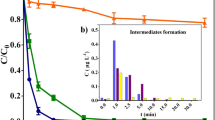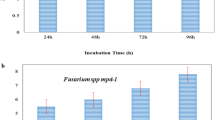Abstract
Microbial degradation of pesticide has been recognized as a potential solution for the disposal of pesticide. Two bacterial strains namely Bacillus licheniformis and Pseudomonas aeruginosa, which were isolated from water and fish intestine, respectively, were allowed to grow in mineral salt solution. The acetonitrile extracts of the bacterial cultures were subjected to thin layer chromatography using two different solvent systems: hexane–chloroform–methanol and cyclohexane–acetone–chloroform. The chromatogram revealed the presence of four metabolites of dimethoate with different Rf values, in the original P. aeruginosa strain using both hexane–chloroform–methanol and cyclohexane–acetone–chloroform solvent systems. Total disappearance of dimethoate spot occurred in the culture of B. licheniformis strain at day 3. Thus, the present study establishes the bacterial degradation of dimethoate and also suggests the role of bacteria in the bioremediation of pesticides.


Similar content being viewed by others
References
Chapalamadugu S, Chaudhry GR (1991) Hydrolysis of carbaryl by a Pseudomonas sp. and construction of a microbial consortium that completely metabolizes carbaryl. Appl Environ Microbiol 57:744–750
DebMandal M (2005) Experiments on exploration of environmental bacteria degrading a pesticide used in agriculture. Thesis, University of Jadavpur
DebMandal M, Mandal S, Pal NK (2002) Evaluation of bioremediation potential of organophosphorus pesticide dimethoate 30% EC by heavy metal and antibiotic resistant Proteus vulgaris isolated from Ganges at Sreerampore, India. Res J Chem Environ 6:49–52
DebMandal M, Mandal S, Pal NK (2005) Plasmid mediated dimethoate degradation by Bacillus licheniformis isolated from a fresh water fish Labeo rohita. J Biomed Biotech 3:280–286
Deshpande NM, Dhakephalkar PK, Kanekar PP (2001) Plasmid-mediated dimethoate degradation in Pseudomonas aeruginosa MCMB-427. Lett Appl Microbiol 33:275–279
Guha A, Kumari B, Bora TC et al (1999) Degradation of endosulfan by Micrococcus sp. and partial characterization of metabolites. Asian J Microbiol Biotech Environ Sci 1:29–32
Hacskaylo J, Bull DL (1963) Metabolism of dimethoate in cotton leaves. J Agr Food Chem 11(6):464–466
Hayatsu M, Hirano M, Tokuda S (2000) Involvement of two plasmids in fenitrothion degradation by Burkhelderia sp. Strain NF100. Appl Environ Microbiol 66(4):1737–1740
Jaffery FN, Chawla G, Kakkar P et al (1989) Toxicology data handbook. Indian Toxicology Research Center, Lucknow, India
Kaur K, Garg RK (2003) Results of detection on the persistence of insecticides (dimethoate and phosphamidon) from soil and paper substrates by thin layer chromatography. In: Anil Aggrawal’s Internet Journal of Forensic Medicine and Toxicology. http://www.geradts.com/anil/ij/vol_004no_002/main.html. Cited November 24, 2003
Kumar S, Mukerji KG, Pal R (1996) Molecular aspects of pesticide degradation by microorganisms. Crit Rev Microbiol 22:1–26
Liu YH, Chung YC, Xiong Y (2001) Purification and characterization of a dimethoate-degrading enzyme of Aspergillus niger ZHY256, isolated from sewage. Appl Environ Microbiol 67(8):3746–3749
Roy S, Hens D, Biswas D, Biswas D, Kumar R (2002) Survey of petroleum-degrading bacteria in coastal waters of Sunderban Biosphere Reserve. World J Microbiol Biotechnol 18(6):575–581
Siddaramappa R, Rajaram KP, Sethunathan N (1973) Degradation of parathion by bacteria isolated from flooded soil. Appl Microbiol 26(1):846–849
Singh BK, Kuhad RC (1999) Biodegradation of lindane by the white-rot fungus Trametes hirsutus Lett Appl Microbiol 28:238–241
Thakur IS (2001) Biodegradation of chlorinated benzoic acid by Pseudomonas fluorescens from a chemostat. Indian J Microbiol 41:27–32
Upadhyay A, Upadhyay K, Nath N (1997) Biophysical chemistry principles and techniques. Himalaya Publishing House, Mumbai
Author information
Authors and Affiliations
Corresponding author
Rights and permissions
About this article
Cite this article
DebMandal, M., Mandal, S., Pal, N.K. et al. Potential metabolites of dimethoate produced by bacterial degradation. World J Microbiol Biotechnol 24, 69–72 (2008). https://doi.org/10.1007/s11274-007-9440-5
Received:
Accepted:
Published:
Issue Date:
DOI: https://doi.org/10.1007/s11274-007-9440-5




